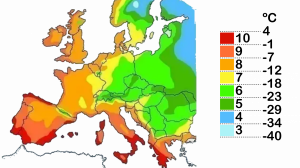Did you ever wondered “what palm species should I chose for my garden that can survive the cold winters”?

In botanical terms, a plant’s hardiness refers its ability to survive adverse conditions. In gardening, it is often used to refer in particular to cold-hardiness, i.e., the minimum temperature data that a plant can withstand. The United States Depatment of Agriculture (USDA)’s Hardiness Index is often used. It classifies plants by their hardiness ranges. The advantage of this index is that it allows the hardiness zones to be projected on the map. However, knowing what is the right palm for a certain place based on the amount of cold it can withstand is much more complex than this. In this post, we look at the components of that complexity.
Microclimate
The level of cold that a plant will experience throughout its life does not only depend on the geographical region in which it is located. It also depends largely on the local microclimate. The minimum temperature in your garden is not necessarily the same as the one in your neighbor’s garden. The temperature varies locally depending on whether we are in an exposed or sheltered place, at a higher or lower altitude above sea level, north or south orientation, and so on.
The size of the plant
Palm trees’ cold-hardiness does not only depend on the species that we acquire, as is often thought. In fact, your palm tree’s resistance to cold will increase as it grows. Although the hardiness of already established, and therefore reasonably-sized, plants is usually reported, seedlings and young palms are usually more sensitive to cold.
Humidity
Humidity is a fundamental factor in determining the minimum temperature a plant can withstand in a given location. Generally, plants withstand more cold in dry conditions. Frosts occur when the ambient temperature drops below 0 ºC and the humidity is high. During a frost, water vapor in the air forms ice crystals. Similarly, soil water freezes. Many plants that can withstand sub-zero temperatures without any problem could be harmed by the formation of such ice crystals on the surface of their leaves or roots. For this reason, the hardiness of a plant is normally greater in areas with dry winters, and it is not recommended to water your palm trees during the coldest weeks of the year.
Frecuency and lenght of the cold periods
A plant’s survival to winters depends not only on the minimum temperature it experiences over the year, but also to a large extent on the general climate that the plant faces. This is, on how cold episodes are balanced with sufficiently beneficial periods of recovery and growth throughout the day, the month, and the year. Put a tropical palm tree in the freezer for a few minutes, and then take it out again to a very suitable place for its growth; you will likely prove it can survive at -20 ºC even if its hardyness is negligeable. This is an extreme example showing that the minimum temperature a palms can withstand will drop drastically when the summer is long enough and adequate for their growth, the minimum temperatures do not last too long, and the maximum temperatures of the cold day are warm enough.
In conclusion,
a palm’s hardiness is difficult to determine, and varies enormously in each particular case. If you have doubts about the feasibility of putting a certain species in your garden, the only way to get an answer may be to try it. Also, if you love a palm tree that is potentially too tropical for your garden, there are protection methods that you can use to protect your palm trees from the cold winters.
